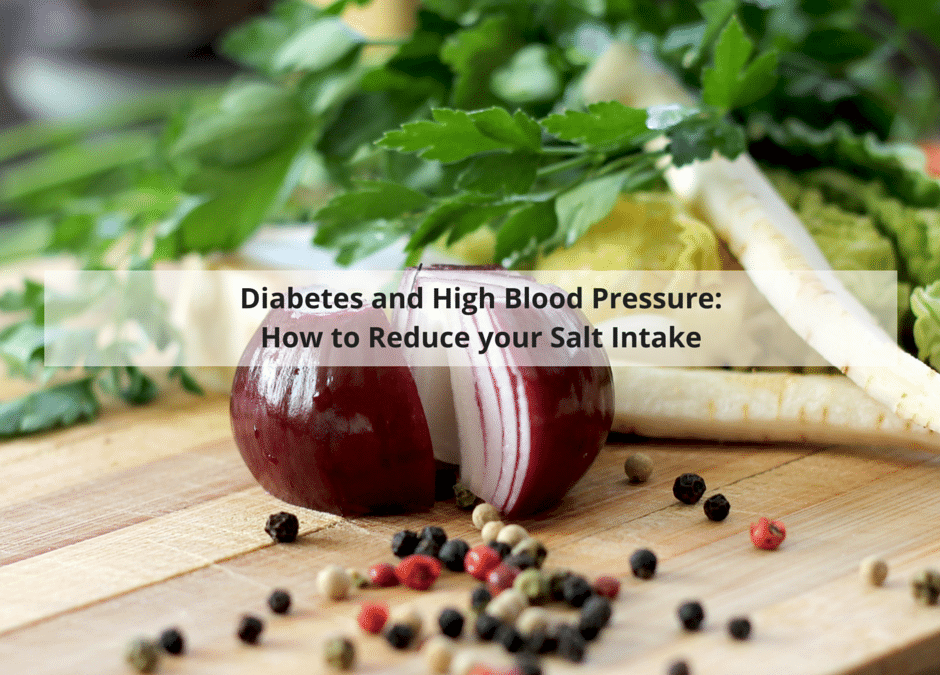Blood Pressure is the force of blood pushing against the walls of the arteries as the heart pumps. High blood pressure, or hypertension, makes heart and stroke problems more likely. Unfortunately, the problem is amplified in diabetes because high blood sugars can also damage the arteries and make them targets for early hardening (atherosclerosis). People with diabetes are much more likely to develop heart disease and/or experience a stroke at an earlier age. People with diabetes may need to take medication to either lower their high blood pressure or even just for preventative care to protect their hearts and kidneys from the effects of high blood pressure. The target blood pressure reading for people with diabetes is less than 130/80 mm Hg.
Modifying our diet and watching sodium intake is an important lifestyle factor when managing blood pressure. Salt – whether sea salt, kosher salt or plain old table salt, is made up of sodium, which we need in small amounts. However, eating too much salt raises the amount of sodium in the blood and retains water. More water in our blood then increases the pressure in our pipes (our arteries) leading to increased hardening of the arteries and increased strain on the delicate blood vessels leading to the kidneys.
Sodium intake from our diets should be no more than 1,500 to 2,300 mg per day. One teaspoon of salt is equal to 2,300 mg of sodium. Here are some useful tips to reduce the salt in your diet.
- Go for fresh food. Many packaged and processed foods can have high levels of sodium, and they may not even taste salty. Canned foods, Breads and rolls, cold cuts/deli meats, cheeses and frozen pizzas are top contributors of sodium. You’ll save on excess sodium by making your own soups and sauces and choosing fresh fruit and vegetables. Try batch cooking and freeze in single-serving portions for later use. Try to limit deli meats to no more than two servings a week and replace deli meats with fresh meats, such as chicken breasts.
- Read the nutrition food label. Compare sodium in different brands for products like processed soups, dressings/sauces, breads, and frozen meals, and choose those with lower sodium. Look for foods that contain less than 360 mg of sodium per serving. Also, look for products with a sodium content less than 10% when you are food shopping.
- Drain and rinse canned goods. Draining and rinsing are effective ways to reduce the sodium content of canned beans, lentils and vegetables. Studies have shown that draining and rinsing canned goods can reduce sodium by 41%.
- Swap the salt for herbs, lemon juice and vinegars. In place of salt, add fresh lemon juice or a splash of vinegar such as balsamic or red wine vinegar to boost the flavors in your cooking. Try adding fresh herbs such as basil, oregano or cilantro to bring out the flavors in your meals. Adding spices such as chili powder, cayenne pepper, curry powder, or red pepper flakes will add punch to savory dishes. Be careful with “Salt Substitutes” – it’s true that they don’t contain Sodium BUT – instead of Sodium, they use Potassium, which the body trades for Sodium so the harmful impact is the same.
- Choose wisely when dining out. When dining out you may want to consider ordering a smaller portion or splitting an entree with your dining partner. Be sure to ask for gravy, dressings and sauces on the side, ask your server questions about how the food is prepared and if substitutions can be made to reduce the salt. For example, order your meat, poultry or fish baked, broiled, poached, roasted or grilled with no salt or sauces made with salt. If you eat a high sodium restaurant meal during the day, make sure you eat a lower sodium meal at home.
Sources: Institute of Food Technologists Conference, Joshua B. Jones and John R. Mount, both from the department of food science and technology at the University of Tennessee, presented “Sodium Reduction in Canned Bean Varieties by Draining and Rinsing


